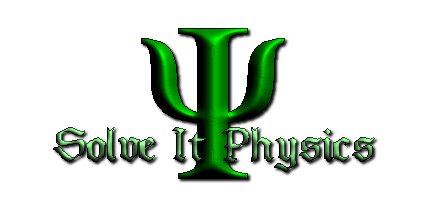

Units and Conversion Factors
In most of the sciences, the system of units used is called "Système International" (SI) which is French for "International System." This is a base-10 system which, unlike the English system, makes manipulations and conversions very easy. You should become very familiar with this system in order to dull the pain your homework creates. All of your homework answers should be left in SI units unless otherwise specified in the problem.
Standard SI Units
These are the most basic units in SI. All other units you will encounter are derived from these units and can be written in terms of the standard units. The last two are units that you will not encounter very frequently, but they still have their place in base units because other units can be derived from them.
| Quantity | Unit | Symbol |
| time | second | s |
| length | meter | m |
| mass | kilogram | kg |
| electric current | ampere | A |
| temperature | kelvin | K |
| amount of a substance | mol | mol |
| luminosity or intensity | candela | cd |
Metric Multipliers
These are called metric multipliers and should be memorized as well. They are used in place of writing out long strings of digits. For instance, instead of writing 4,200,000 grams, metric multipliers can be used to write 4.2 Mg (read 4.2 mega-grams). This is a convention that makes things easier to read. Each metric multiplier is a symbol that is assigned a power of 10. The most commonly used metric multipliers are highlighted in blue. The frequency of use depends on which field of physics you are dealing in.
| Prefix | Symbol | Power of 10 |
| exa | E | 1018 |
| peta | P | 1015 |
| tera | T | 1012 |
| giga | G | 109 |
| mega | M | 106 |
| kilo | k | 103 |
| hecto | h | 102 |
| deka | da | 101 |
| deci | d | 10-1 |
| centi | c | 10-2 |
| milli | m | 10-3 |
| micro | μ | 10-6 |
| nano | n | 10-9 |
| pico | p | 10-12 |
| femto | f | 10-15 |
| atto | a | 10-18 |
Derived Units
Derived units are combinations of the standard units.
| Quantity | Units | Symbol | Base Units |
| Force | newton | N | kg*m / s2 |
| Energy | joule | J | kg*m2 / s2 |
| Work | joule | J | kg*m2 / s2 |
| Power | watts | W | kg*m2 / s3 |
| Pressure | pascal | Pa | kg / (m* s2) |
| Frequency | hertz | Hz | /s or s-1 |
| Electrical Resistance | ohm | Ω | (kg*m2 ) /(A2*s3) |
| Electrical Potential | volt | V | (kg*m2 ) /(A*s3) |
| Electrical Charge | coulomb | C | A*s |
| Capacitance | farad | F | (A2*s4) /(kg*m2 ) |
| Magnetic Field | tesla | T | kg /(A*s2) |
| Magnetic Flux | weber | Wb | (kg*m2 ) /(A*s2) |
| Inductance | henry | H | (kg*m2 ) /(A2*s2) |
Unit Conversions
Unit conversions are used to convert between one system of units and another or within a system for simplification purposes. In Physics and mathematics they are primarily used to convert from English units to metric units. There is also a table of abbreviations that will explain the symbols used in the Unit Conversions Table.
| Length | Time | |
| English Conversions | English/Metric Equivalents | *English and Metric Use the Same Units of Time* |
| 1 ft = 12 in | 1 in = 2.54 cm | 1 min = 60 s |
| 3 ft = 1 yd | 1 ft = 30.5 cm | 1 hr = 60 min |
| 5280 ft = 1 mi | 1 m = 39.37 in | 1 hr = 3600 s |
| 1 m = 3.28 ft | 24 hr = 1 d | |
| Metric Conversions | 1 mi = 1.61 km | 365 d = 1 yr |
| 100 cm = 1 m | 1 km = .621 mi | 10 yr = 1 decade |
| 1000 m = 1 km | 1000 yr = 1 millennium | |
| Volume | ||
| Metric Conversions | English/Metric Equivalents | |
| 1 L = 1000 mL = 1000 cm3 | 1 L = 1.057 qt | |
| 1 L = 54.6 in3 | ||
| English Conversions | 1 gal = 3.78 L | |
| 1 gal = 4 qt = 231 in3 | 1 m3 = 35.31 ft3 | |
| Units of Measurement (Alphabetical) | |
| Abbreviated Form | Expanded Form |
| cm | centimeter |
| d | day |
| ft | foot |
| hr | hour |
| in | inch |
| km | kilometer |
| m | meter |
| mi | mile |
| min | minute |
| s | second |
| yd | yard |
| yr | year |
© 2006, Spitfire Science

This work is licensed under a Creative Commons Attribution-NonCommercial-NoDerivs 2.5 License.